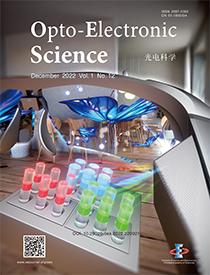2022 Vol. 1, No. 12
Cover story: Qian YZ, Yang ZY, Huang YH, Lin KH, Wu ST. Directional high-efficiency nanowire LEDs with reduced angular color shift for AR and VR displays. Opto-Electron Sci 1, 220021 (2022).
Near-eye displays such as augmented reality (AR) and virtual reality (VR) show a great potential in delivering digital images to human eyes. To display high-fidelity crystal-clear images, a compact and lightweight directional light engine with high-resolution density and brightness is desirable. For the immersive VR headsets, presently active-matrix liquid crystal displays (LCDs) and organic light-emitting diode (OLED) displays are two dominating technologies. On the other hand, to enable high ambient contrast ratio for the optical see-through AR headsets, liquid-crystal-on-silicon (LCOS), laser beam scan, digital micromirror device, micro-OLED, and micro-LED are competing technologies. Each technology has its own pros and cons. For examples, the non-emissive LCOS requires a larger illumination volume; the raster laser beam scan suffers from limited frame rate and lower resolution; and the emissive micro-OLED has tradeoff between brightness and lifetime. Although micro-LEDs can offer an ultrahigh brightness and long lifetime, how to achieve high-resolution density and high efficiency simultaneously remains a challenge. Recently, dot-in-wire nanowire LEDs are attracting attention because of its out-of-plane structure and excellent electrical performance. Such nanowires with submicron diameter behave as waveguide, and therefore, can efficiently couple the emitted light out of the structure in normal direction. Moreover, the fabrication difficulty has been significantly reduced since the emission wavelength can be controlled by varying the nanowire diameters. By properly designing the geometry of RGB nanowires separately, the angular color shift within the accepting cone of AR/VR imaging system can be suppressed significantly. In addition, in comparison with micro-LEDs, nanowire LEDs exhibit a higher light extraction efficiency as the pixel size decreases to below 10 mm. This feature is particularly important for high-resolution density displays. Therefore, the dot-in-wire LED will be a strong contender for AR/VR light engines as the technology becomes more mature.

-
{{article.year}}, {{article.volume}}({{article.issue}}): {{article.fpage | processPage:article.lpage:6}}. doi: {{article.doi}}{{article.articleStateNameEn}}, Published online {{article.preferredDate | date:'dd MMMM yyyy'}}, doi: {{article.doi}}{{article.articleStateNameEn}}, Accepted Date {{article.acceptedDate | date:'dd MMMM yyyy'}}CSTR: {{article.cstr}}
-
{{article.year}}, {{article.volume}}({{article.issue}}): {{article.fpage | processPage:article.lpage:6}}. doi: {{article.doi}}{{article.articleStateNameEn}}, Published online {{article.preferredDate | date:'dd MMMM yyyy'}}, doi: {{article.doi}}{{article.articleStateNameEn}}, Accepted Date {{article.acceptedDate | date:'dd MMMM yyyy'}}CSTR: {{article.cstr}}

 E-mail Alert
E-mail Alert RSS
RSS


